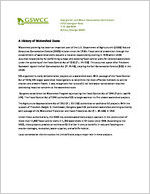Georgia Soil and Water Conservation Commission 4310 Lexington Road P. O. Box 8024 Athens, Georgia 30603
A History of Watershed Dams
Watershed planning has been an important part of the U.S. Department of Agriculture's (USDA) Natural Resources Conservation Service (NRCS) mission since the 1930s. Flood control prevention through the establishment of watershed dams became a national responsibility starting in 1936 when USDA assumed responsibility for performing surveys and devising flood control plans for selected watersheds under the authority of the Flood Control Act of 1936 (P.L. 74-738). This occurred a year after President Roosevelt signed the Soil Conservation Act (PL 74-46), creating the Soil Conservation Service (SCS) in the USDA.
SCS organized its early demonstration projects on a watershed basis. With passage of the Flood Control Act of 1936, SCS began watershed investigations to determine the most effective methods to control erosion and prevent floods. It was recognized that successful soil and water conservation required addressing resource concerns at the watershed scale.
Congress established the Watershed Program by enacting the Flood Control Act of 1944 (Public Law 78534). The Flood Control Act of 1944 authorized SCS to begin work on its first eleven watershed projects.
The Agricultural Appropriations Act of 1953 (P.L. 83-156) authorized an additional 63 projects. With the support of President Dwight D. Eisenhower, Congress gave SCS permanent watershed planning authority with passage of the Watershed Protection and Flood Prevention Act (P.L. 84-566) in 1954.
Under these authorizations, the NRCS has assisted watershed project sponsors in the construction of more than 11,800 flood control dams in 1,300 watersheds in 47 states since 1948. According to the NRCS, these projects provide an estimated $2.2 billion in annual benefits in reduced flooding and erosion damages, recreation, water supplies, and wildlife habitat.
Local conservation districts across the United States play a major role in these projects.
